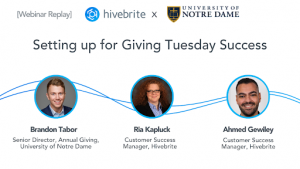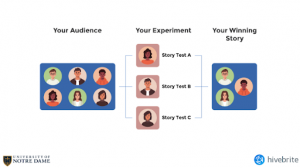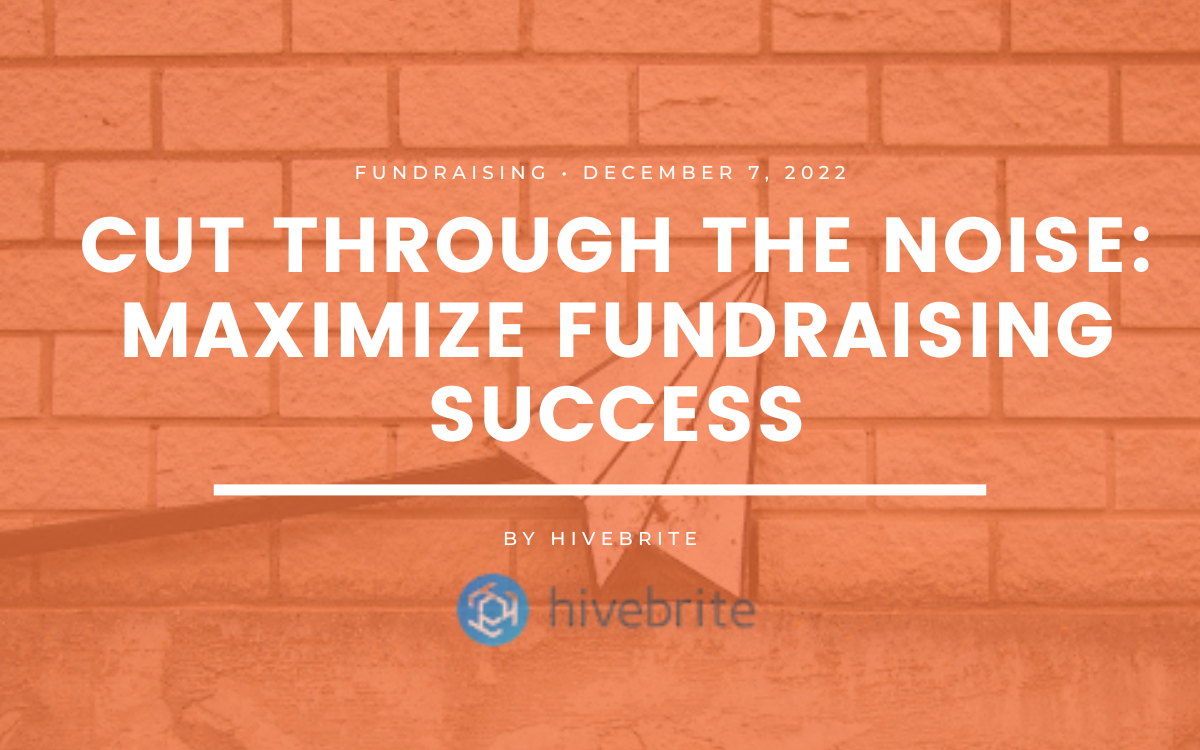Cut Through The Noise: Maximize Fundraising Success
4 min to read ✭ Hivebrite is here to share how to keep your organization's fundraising strategies fresh and maximize fundraising success!
Keeping your organization’s fundraising strategies, tools, and engagement methods fresh and innovative gets more critical every year as you look to maximize fundraising success.
It’s no secret that we are subject to massive information overload in today’s digital age. It’s no different for your donors.
They are inundated with information and requests for contributions—especially towards the end of the year when 35% of all giving happens!
So how can you ensure your messages cut through the noise and strike a chord with your donors?
Hivebrite organized a webinar with Brandon Tabor, Senior Director of Annual Giving at the University of Notre Dame, Ria Kapluck, and Ahmed Gewiley, Customer Success Managers at Hivebrite, to discuss strategies and best practices to maximize fundraising on Giving Tuesday and beyond.
Watch the recording and discover how to harness personalization, share compelling stories to drive action, meaningfully engage your stakeholders, and more!

Strapped for time? Keep scrolling to discover our top five takeaways to maximize fundraising success!
-
The Power of Storytelling
Storytelling is a potent tool to build a connection with your donors. Compelling stories grab attention, humanize your organization, and drive action.
Every campaign at the University of Notre Dame is run through the following storytelling process:
| Step | Example |
| 1. Who is your audience? | People who have never donated before. |
| 2. What do you want them to walk away thinking, feeling, or doing? | Giving Tuesday is a global generosity movement. Now would be a great time for me to join this movement and make an impact. |
| 3. What channels will we use to reach your audience? | Email and through the organization’s online community. |
| 4. What are the goals? (Or, in other words, what does great look like?) | 1,000 new donors and 400,000 USD in revenue. |
| 5. What are the stories that you will tell that audience through your chosen channels to achieve your desired thought, feeling, or action to help you reach your goal? | Gifts of all sizes make a huge difference. Last year gifts of 200 USD or less funded scholarships for 57 deserving students! |
-
A/B Test Whenever You Can
A/B testing emails is critical to give your campaigns the best chance of producing results!
In a nutshell, A/B testing pits two (or more) versions of the same email against each other to see which performs better. The different versions are sent to similarly sized segments of your audience.
Over at the University of Notre Dame, Brandon and his team A/B test whenever they have the opportunity.
Each campaign is composed of a series of emails. The first email is known as the test email. One variable the team tests is the story theme. The team sends three different story themes to its audience: audience segment A’s email theme will be nostalgia, audience segment B’s will be urgency, and segment C’s will be tradition.

The story theme that achieves the highest click-through rate will then be used in the remaining emails in the campaign.
The team segments the audience randomly and based on criteria such as first-time donors or young alumni to determine what message themes work best with each subsection of their audience.
Continual A/B testing is ideal for refining your campaigns and optimizing results! You can also run tests on your website and landing pages. Just remember, it’s best to test one variable at a time. If you send emails with different story themes and button colors, you won’t know if the winning email got a higher click-through rate because of its theme or button.
-
Choose the Right Technology
Finding the right technology to support your fundraising campaigns can be a game-changer—from automating tasks to save time to enriching strategies.
The University of Notre Dame uses Hivebrite’s all-in-one community management platform to engage its alumni, encourage donations, and facilitate fundraising campaigns.
The team can enhance storytelling by creating articles in the News Module—such as donor and impact stories—and sharing them via the community’s live feed and external channels to increase reach. They can tag people when sharing content, send out push notifications to alert members of new content, and automatically pull articles into personalized email campaigns!
The university benefits from a highly diverse alumni community. By segmenting subgroups within the online community based on interests, locations, chapters, etc., the team can then share the most relevant stories with each subgroup!
-
Quick Tips for Optimizing Email

Thanks to their robust A/B testing, the Fundraising Team at Notre Dame team has identified quick tips to optimize emails. Here are some of our favorites mentioned in the webinar:
- Don’t waste words—get to your point.
- Add the recipient’s name for a personalized touch.
- Including images? Put your CTA before the image.
- Spell out URLs. People can feel uncomfortable clicking buttons when they can’t see the URL. Be transparent and spell it out.
- A P.S. receives high engagement.
-
It’s Not Only About the Dollar
Sure, the bottom line is critical, but there are other indicators of success!
Brand sentiment is also crucial. Ask yourself, have your stories educated more people about the work you do and the impact your organization has?
Also, what have you learned that you can implement or build on in future campaigns?
In terms of campaign performance, beyond dollars raised, also consider metrics such as:
- The number of total donors
- The number of first-time donors
- The number of repeat donors and their gift increase
- The average gift size
- The largest gift
- The number of donors coming from key segments of your audience
- New volunteers that have joined your organization
Watch the webinar in full to discover more about these takeaways and other topics discussed!
PS: Online communities have skyrocketed in recent years as organizations understand the immense value they can bring to their business.
So, what does this mean for your nonprofit?
Your stakeholders (supporters, prospects, volunteers, donors, etc.) now want meaningful relationships (with your organization and peers) and a sense of belonging more than ever.
Online communities help create deeper engagement with supporters, volunteers, and donors to create better outcomes: more donations, more advocates, and more people mobilized for the cause. Discover more.





